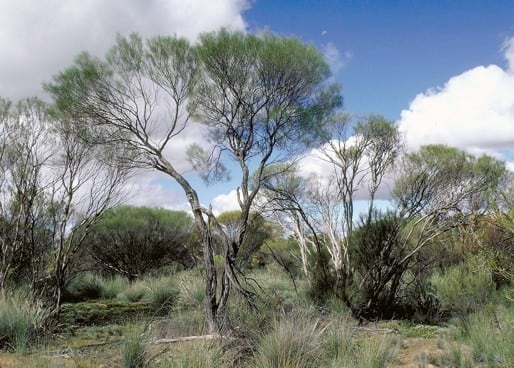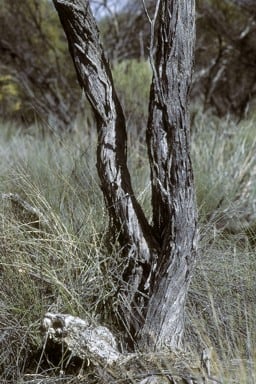Acacia synoria Maslin
WATTLE
Acacias of Australia
Common Name
Goodland’s Wattle
Family
Fabaceae
Distribution
South west W.A. where it is known from just two populations, NE of Kalannie and c. 30 km further N from near Mt Gibson.
Description
Shrub or tree 2–5 m high, trunks commonly curved or slightly crooked. Branchlets glabrous, red-brown at extremities. Phyllodes erect, mostly shallowly incurved, terete, subrigid, (5–) 6–9 (–10.5) cm long, slender (0.7–1 mm diam.), acuminate, innocuous to subpungent with straight to curved or sub-uncinate tips, glabrous except pulvinus obscurely appressed puberulous on adaxial surface, light green, with 8 raised longitudinal nerves each separated by a distinct furrow; gland 0–4 mm above pulvinus. Inflorescences simple; heads sub-globular to shortly cylindrical, light golden; buds resinous; peduncles 2–5(–6) mm long, glabrous. Flowers 5-merous; sepals free. Pods terete, scarcely to shallowly constricted between the seeds, straight to shallowly curved, 5–9 (–10) cm long, 1–2 mm wide, thinly coriaceous-crustaceous, pendulous, glabrous, light brown. Seeds longitudinal, oblong to elliptic, 2.5–3 mm long, light brown but obscurely mottled greyish or pale yellowish; aril almost as long as seed, lemon yellow.
Phenology
Flowers Oct.–Dec.
Habitat
Grows in sandy loam or clay in association with granite rocks.
Specimens
W.A.: [precise locality withheld for conservation purposes] B.R.Maslin 7518 (PERTH); 31 Oct. 1993, S.Webster (PERTH); R.J.Cranfield 8558 (PERTH).
Notes
Appears to have no particular close relatives but is generally similar to the more southerly distributed A. sessilispica which differs in its sessile, spicate inflorescences, 4-merous flowers, wider pods and white seed arils. A variant of uncertain taxonomic status, A. sp. Moorine Rock (B.R.Maslin 4474), and other species with superficially similar phyllodes which grow in the general vicinity of where A. synoria occurs are discussed by B.R.Maslin, Nuystia 17: 239 (2007).
FOA Reference
Data derived from Flora of Australia Volumes 11A (2001), 11B (2001) and 12 (1998), products of ABRS, ©Commonwealth of Australia
Author
B.R.Maslin, J.Reid
This identification key and fact sheets are available as a mobile application:
URL: https://apps.lucidcentral.org/wattle/
© Copyright 2018. All rights reserved.










